Resource information
Land change in the Greater Antilles differs markedly among countries because of varying socioeconomic histories and global influences. We assessed land change between 2001 and 2010 in municipalities (second administrative units) of Cuba, Dominican Republic, Haiti, Jamaica, and Puerto Rico. Our analysis used annual land-use/land-cover maps derived from MODIS satellite imagery to model linear change in woody vegetation, mixed-woody/plantations and agriculture/herbaceous vegetation. Using this approach, we focused on municipalities with significant change (p ? 0.05). Between 2001 and 2010, the Greater Antilles gained 801 km2 of woody vegetation. This increase was mainly due to the return of woody vegetation in Cuba, and smaller increases in Puerto Rico and the Dominican Republic. Despite relatively similar environments, the factors associated with these changes varied greatly between countries. In Puerto Rico, Dominican Republic, and Jamaica, agriculture declined while mixed-woody vegetation increased, mostly in montane regions. In contrast, Cuba experienced an extensive decline in sugarcane plantations, which resulted in the spread of an invasive woody shrub species and the increase in woody vegetation in areas of high agricultural value. In Haiti, the growing population, fuelwood consumption, and increase in agriculture contributed to woody vegetation loss; however, woody vegetation loss was accompanied with a significant increase in the mixed woody and plantations class. Most regional analyses often treated the Greater Antilles as a homogeneous unit; our results suggest that historical and socio-economic differences among countries are crucial for understanding the variation in present day land change dynamics.


